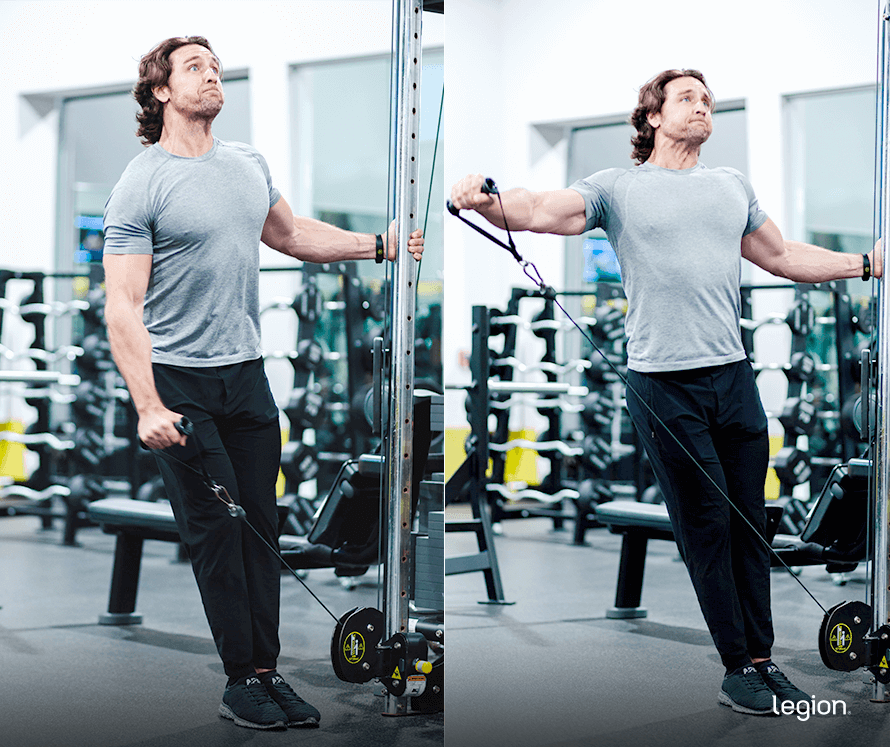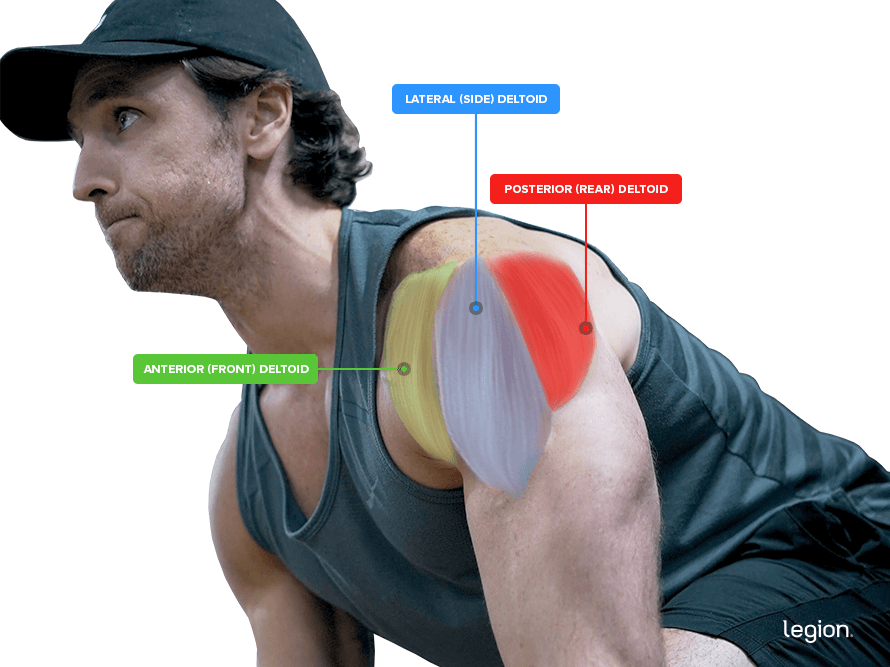Cable lateral raises are a cornerstone exercise for building well-balanced and strong shoulders.
They’re one of the few exercises that emphasize the “side delts,” the part of your shoulder muscles most responsible for broadening your upper body.
In this expert guide, you’ll learn what the cable lateral raise is, how to do it with proper form, which muscles it works, tips on how to get the most out of the exercise, the best alternatives and variations, and more.
What Is the Cable Lateral Raise?
The cable lateral raise is a shoulder exercise involving a pulley machine.
It’s similar to the dumbbell side lateral raise, except you use a cable instead of a dumbbell and typically train each arm independently (which is why many refer to it as the “single-arm cable lateral raise”).
The main benefits of performing lateral raises on a cable machine are that they emphasize your lateral deltoids (“side delts”), the sections of your shoulder muscles that contribute most to shoulder width.
Additionally, unlike dumbbells, using the cable machine for lateral raises provides constant tension throughout the entire range of motion. This constant tension stimulates your muscles differently than free weights, which likely benefits muscle growth.
How to Do the Single-Arm Cable Lateral Raise
To master the lateral raise on a cable machine, split the exercise into three parts: set up, raise, and descend.

1. Set up
Set the pulley on a cable machine to the lowest setting and attach a single handle attachment.
Stand with your feet either touching or shoulder-width apart, parallel to the handle, and your right foot closer to the handle than your left.
Grab the handle with your left hand and the pulley machine with your right hand (most people prefer to grab the metal column that holds the pulleys), then lean your body to the left until your right arm fully extends.
2. Raise
While keeping your back straight and your core tight and maintaining a neutral grip (thumbs pointing forward) with a slight bend in your elbow, drive your elbow out and up.
Don’t raise your arm directly out to your side; instead let it move forward about 15-to-30 degrees (if you imagine a clock face, your left arm should be between 9 and 10 when viewed from above). Continue raising the handle until your upper arm is parallel to the floor.
3. Descend
Reverse the movement and return to the starting position. This should mirror what you did during the raise.
Muscles Worked by Cable Lateral Raises
The main muscles worked by the single-arm cable lateral raise are the deltoids, or “shoulder muscles.”
Here’s how these muscles look on your body:

Although single-arm cable lateral raises train your posterior and anterior deltoid, they’re particularly effective at targeting the lateral deltoid (hence the name).
They also train your traps and rotator cuff muscles to a lesser extent.
Cable Lateral Raise Tips
1. Experiment with your arm angle.
When performing the cable lateral raise, most people find allowing their upper arms to move forward by 15-to-30 degrees most comfortable. However, this form won’t suit everyone.
If you find it uncomfortable or don’t feel your side delts working, try adjusting the angle of your arms relative to your torso as you lift the weight.
Experiment with lifting your arms straight out to the sides or slightly more forward, but avoid going further forward than 45 degrees, as this will place less emphasis on your side delts, negating the benefits of the exercise.
2. Experiment with your foot position.
Some find lateral raises with cables awkward because they involve pulling the cable across your body.
If your legs obstruct the movement, adjusting your foot position can help. For instance, you can position the foot closest to the machine slightly back and the foot further away slightly forward, creating a gap for the cable to pass through.
Alternatively, stepping forward with both feet and allowing the cable to pass behind your legs can also be effective.
3. Experiment with your body angle.
Research shows that the supraspinatus (a rotator cuff muscle) is most active during the beginning of the lateral raise, whereas the side delt becomes more involved between the middle and the end of the range of motion. Thus, leaning away from the cable machine can help emphasize the side delts.
How far you lean away from the machine depends on personal preference, shoulder mobility, comfort, and so forth, so play with your lean angle to find a position that works best for you.
The Best Cable Lateral Raise Alternatives & Variations
1. Dumbbell Lateral Raise
The dumbbell lateral raise is an effective dumbbell exercise for training the side delts, making it an excellent alternative to the cable variation if you don’t have access to a pulley machine.
- Stand up straight with a dumbbell in each hand.
- Raise your arms out to the sides until your upper arms are parallel to the floor.
- Reverse the movement and return to the starting position.
2. Dual Cable Lateral Raise
The dual cable lateral raise trains both sides of your body simultaneously, saving time compared to the single-arm variation. However, it also involves a slightly shorter range of motion, as you can’t lean away from the machine and your hands cross in front of you, which may slightly limit muscle growth compared to the regular version.
- Position yourself in the center of a cable crossover machine.
- Grab the handle nearest your right foot with your left hand and the handle nearest your left foot with your right hand, allowing your arms to cross in front of your body.
- Raise your arms out to the sides until your upper arms are parallel to the floor.
- Reverse the movement and return to the starting position.
3. Machine Lateral Raise
The main benefit of machine lateral raises is that the weight rests on your forearms or upper arms instead of being in your hands. This makes machine lateral raises more comfortable for many people, especially if you have elbow issues.
- Sit on the lateral raise machine seat, grab the handles, and place your forearms (or upper arms, depending on the machine) against the pads.
- Raise the arm pads toward the ceiling by pushing your forearms into the pads until your upper arms are parallel to the floor.
- Reverse the movement and return to the starting position.










